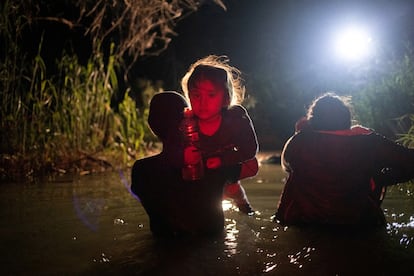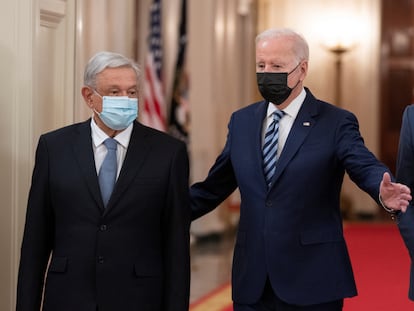The Nicaraguans who are learning to swim to avoid drowning in US river crossing
The flow of migrants from the Central American country has become unstoppable; a dozen have died in the attempt to ford the Rio Grande between March and April

Seeing his son with the water below his waist, standing firm on the stones of the riverbed, Pablo Cuevas ruled out using the 60-meter rope he had bought to cross the Rio Grande with his family, because it would prove more of a hindrance than a useful tool in their desperate attempt to reach American soil.
“Dad! The river is calm!” shouted the 22-year-old from about 30 meters away from the bank. Faced with the imminent arrival of Mexican or American border agents, the man let go of the rope, hugged his five-year-old grandson very tightly and entered the waters. It was mid-morning on April 17, less than a month ago. The Rio Grande, a “treacherous” river according to the migrants who have lived to tell the tale, was calm that day. It was a lucky break for this family that fled Nicaragua because of their father’s job: Pablo Cuevas is a renowned human rights defender in his country.
Accustomed to tense situations back home due to his clashes with gangs and police officers under the dictatorship of Daniel Ortega and Rosario Murillo, Cuevas concealed his fear of jumping into the river so that his wife, daughter-in-law and his other grandson would not lose the courage they had rehearsed during the 40-day journey to Ciudad Acuña, in Mexico’s Coahuila state. The trip had taken them across Central America and Mexico, along a road rife with robberies, kidnappings, extortion, fatigue, hunger and death that 49,738 Nicaraguans followed in the first quarter of 2022 alone, according to the United States Customs and Border Protection. That is the largest number of migrants from this country to try to cross the US border in recent history.

It was on the first week of March, as he sat inside his home in Managua, that Cuevas made the decision to join this unprecedented exodus to escape the political violence and precarious economic situation that Nicaragua has been experiencing since 2018, following social protests that were brutally repressed. by the police and paramilitary groups. The country’s sociopolitical crisis has deepened since June 2021, when the Ortega-Murillo presidential couple intensified the hunt for opponents that facilitated Ortega’s re-election and perpetuation in power.
“Before the government closed the CPDH (Permanent Human Rights Commission),” says Cuevas, alluding to the last such organization left in Nicaragua, I received threats and intimidating messages. Someone from the government told me that I had better leave... I have never been a fan of desk jobs, I always liked to be out doing field work, but there came a point when I could no longer practice freely, and my wife was having nervous breakdowns thinking that they could arrest me at any moment. So we decided to leave, and the route through the Rio Grande seemed the best, after analyzing it with many users I had who had already crossed into the United States,” he tells EL PAÍS.
The Cuevas family’s greatest fear was drowning in the river. Between March and April 2022, news of Nicaraguans killed in those waters shocked the country: 10 people registered by the Association of Nicaraguans in Mexico, although there are other agencies that put the number at 14, such as the non-profit Comunidad Nicaragüense en Texas. There were cases like that of a four-year-old girl swept away by the current, or the most recent drowning, on May 1, of Calixto Nelson Rojas, a radio host for Radio Darío, a station that was burned and attacked by the Sandinista regime. The death of the radio journalist was recorded by a Fox News reporter: it happened before the eyes of US and Mexican border agents who did not help him because they were prohibited from doing so, even as Rojas cried out for help. The reason for not saving him was that a Border Patrol officer allegedly drowned weeks ago while trying to rescue two migrants.

Cuevas, a man who was well informed thanks to his work as a human rights defender, knew about the dangers of crossing the river. “We began to do introspection exercises with the family, to remember one of our camping trips to the sea in Nicaragua, specifically once an undercurrent dragged us out to sea, but we were able to swim and save ourselves,” says the lawyer, who is now living in Florida, where he has started an organization to help other Nicaraguan migrants. “So I told my family to remember to bury their feet firmly in the bottom so we could cross the river.”
The Cuevas were able to cross without a rope and without a life jacket. However, some 3,000 kilometers south of the Rio Grande, in Nicaragua, dozens who have decided to leave the country and do not know how to swim are taking precautions before heading north: they are signing up for Mario Orozco’s swimming lessons.
‘I know it is a dangerous river’
With no major signs of a solution to the sociopolitical crisis, Nicaragua has become a country on the run. In 2021 alone, the United States Border Patrol tallied 87,530 Nicaraguans who tried to enter the southern border without documents. An exponential increase occurred in June, when the Ortega-Murillos imprisoned all their adversaries and ended the possibility of a resolution to the conflict through transparent elections. If one asks people in Nicaragua about the best decision in this scenario, the majority, especially young people, will answer the same thing: to leave. Migrant groups leave at dawn from some gas stations in Managua, while others who feel politically persecuted, such as Pablo Cuevas, do so clandestinely across the Honduran border.
Border Patrol figures from January to March of this year provide a measure of this booming exodus: 70,066 Nicaraguans have surrendered to patrol officers. “But there is an underreporting,” says the Association of Nicaraguans in Mexico. There has been a change in the migratory dynamics from this country, driven by political violence that has aggravated endemic ills (a precarious economy and lack of jobs). In 2018, at least 120,000 Nicaraguans applied for asylum in Costa Rica. But the pandemic plunged this latter country into an unemployment crisis and Nicaraguans reconfigured their flight path. First, because Costa Rica has collapsed and second, because Joe Biden’s immigration promises were interpreted as greater flexibility by the US government.
Suddenly, the migrant caravans in which Hondurans and Salvadorans used to predominate began to be led by Nicaraguans, who are now also prey to the mafias along the route. Among those preparing to flee the country, crossing the Rio Grande became the best option despite the dangers of its waters. That is why the post on Facebook by professional swimmer Mario Orozco offering free lessons went viral in Nicaragua.
Orozco assures that some of his friends drowned in the Rio Grande and that moved him into action. “I am a professional swimmer, I know the techniques to swim in open waters. So I took one of my days off to teach and avoid these tragedies,” he says, emphasizing that his work is humanitarian and not political. The swimmer is concise and prefers not to delve into details. He does not say why but, for those who live in Nicaragua, it is understood: anything that the Sandinista government views as criticism can cost jail time.
The pool where Orozco teaches is usually packed, as a reflection of the urgency to leave Nicaragua. “I know it is a dangerous river,” says Roberto García, a Nicaraguan who left the country a few weeks ago and is now in Tapachula, Mexico, where he is “preparing myself mentally” to ford the Rio Grande. “There are those who take swimming lessons; I, for example, am watching YouTube videos, asking other friends who have already crossed where it is less deep; the current less strong… I am afraid, but the situation is more critical when I am going to cross with my son,” confesses García, an auto refrigeration technician who used to provide services to the Supreme Court of Justice.
García was imprisoned for seven months for participating in the 2018 protests in Nicaragua. Upon release from prison, his workshop was never able to recover due to police harassment and lack of customers. Weary, he decided to migrate. “I don’t even want to think about the day I’m going to cross the river with my wife and son. It unsettles me. My son is 10 years old and I only think of him, especially when I see so many brothers drowning in the news… like that announcer from León. It was a horrible video. One feels powerless. I don’t want a similar video of us,” he says. He also doesn’t want to leave one last message like that of the radio host Calixto Rojas before jumping into the waters of the Rio Grande: “Today I’m leaving for Piedras Negras at one in the afternoon. Tomorrow at eight I will be trying to cross the river.”
Tu suscripción se está usando en otro dispositivo
¿Quieres añadir otro usuario a tu suscripción?
Si continúas leyendo en este dispositivo, no se podrá leer en el otro.
FlechaTu suscripción se está usando en otro dispositivo y solo puedes acceder a EL PAÍS desde un dispositivo a la vez.
Si quieres compartir tu cuenta, cambia tu suscripción a la modalidad Premium, así podrás añadir otro usuario. Cada uno accederá con su propia cuenta de email, lo que os permitirá personalizar vuestra experiencia en EL PAÍS.
¿Tienes una suscripción de empresa? Accede aquí para contratar más cuentas.
En el caso de no saber quién está usando tu cuenta, te recomendamos cambiar tu contraseña aquí.
Si decides continuar compartiendo tu cuenta, este mensaje se mostrará en tu dispositivo y en el de la otra persona que está usando tu cuenta de forma indefinida, afectando a tu experiencia de lectura. Puedes consultar aquí los términos y condiciones de la suscripción digital.
More information
Últimas noticias
Most viewed
- Reinhard Genzel, Nobel laureate in physics: ‘One-minute videos will never give you the truth’
- Oona Chaplin: ‘I told James Cameron that I was living in a treehouse and starting a permaculture project with a friend’
- Pablo Escobar’s hippos: A serious environmental problem, 40 years on
- Why we lost the habit of sleeping in two segments and how that changed our sense of time
- Chevy Chase, the beloved comedian who was a monster off camera: ‘Not everyone hated him, just the people who’ve worked with him’











































